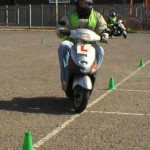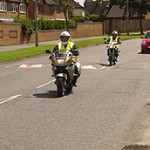First things first – Compulsory Basic Training (CBT) is not a test, it is a structured training course.
It is not possible to fail the course.
Most people will complete the training within a day.
If your instructor feels that you need more training to bring you up to a competent standard then you will be asked back for extra instruction.
Read more: Can you fail a CBT?
Thomas Elliot recently completed his CBT and this is his account of what to expect.
You are likely have many questions about what awaits you in the Compulsory Basic Training course.
- What should you expect from the CBT?
- How can you best prepare?
- Are you going to fail if you stall the bike before you even get on the road?
The course has 5 different sections, these are known as the 5 elements of CBT, but keep reading for answers and tips from somebody who has recently passed their CBT.. Me!
Save Money On Your Motorcycle Insurance
- You could pay less than £195*
- Compare quotes from 25+ UK providers
- Fill in one form to compare top bike insurers
Preparation for your CBT
So, let’s make some assumptions. You have booked your CBT at a motorcycle training school which you are confident is both reputable, and reasonably local.
Now, the big day has arrived, to get the most from your CBT there are a few things you should be sure of before you even leave the house.
Some may be more surprising than others.
- Firstly, be sure to eat. Your day is going to be great fun, but there’s going to be a lot of concentrating. To be able to give your full attention, knock out the distraction of hunger.
- Secondly think about clothing. If it’s cold, then it will be colder on a motorcycle. If it’s hot, it will still feel colder on a motorcycle.
There are a few mandatories with clothing on your CBT. Ideally motorcycle protection gear.
But let’s be honest, you probably don’t own a set of leathers. I didn’t.
Important
At a minimum aim for sturdy boots, heavy jeans, a good thick jacket, and a pair of motorcycle gloves. Most CBT centres will provide you with a helmet, gloves and a high visibility jacket, but check before you go.
Double check you’ve got your driving licence and any paperwork you have been asked to bring along and you are good to go.
At the Compulsory Basic Training centre (remember its not a test!)

Make yourself comfortable, have a chat.
You will be with them all day after all, and there is a lot to be said for group camaraderie!
I got on really well with the other two people on my course, their encouragement made the practical elements that little bit easier.
Sounds daft, but it can make all the difference.
Eyesight and Safety Talk
Time for the classroom element of the CBT. An eyesight test and a safety talk.
I know, this isn’t what you are here for, you probably haven’t even seen a motorcycle yet, but it’s all super important and actually very interesting.
My instructor gave us some really great advice about what to look for, and what to avoid when buying protective gear.
This proved invaluable later down the line.
Basic Controls
You will now be fitted with a helmet and taken out to the training area. Probably a large private car park or something similar.
Time to meet the motorcycles.
Now depending on whether you have opted to take your CBT on either a manual or automatic motorcycle you will be stood beside either a scooter, or a 125cc motorcycle such as the Honda CBF125.
A talk from your instructor will familiarise you with the bike controls.
My advice? Research. Become a little obsessed with all things motorcycle a few days before your CBT. Read up on the basics of bike and clutch control. On Reddit, r/motouk has an active, and incredibly friendly community of motorcyclists in the UK who have already built up a great database of first hand advice. I learned a lot simply scrolling those conversations.
Research will always help with most elements of motorcycling, but the more you do before your CBT, the less overwhelming the whole experience will be.
Ride your pushbike and imagine using a clutch and footbrake. Sure it felt silly, but when it came to my CBT and I was confident with where the controls were on the bike, my confidence thanked me for it.
Off Road Training
Bike Control
You will be asked to start the bike and ride it as slowly as possible in a straight line.
Sounds easy right?
Well it involves clutch control and balance, and for me, this simple task was depressingly difficult at the start of the day.
Top tip? It doesn’t matter how much throttle you use, just control the input with your clutch. Find the point of friction and dance around it, keeping the bike crawling on.
Another tip? Ride the rear brake. Dragging on the rear brake stabilizes the bike, meaning you can continue to move slowly, and with stability – Try it, it’s amazing.
Controlled Stops
With moving in a straight line out of the way you will move onto (logically) controlled stops.
Every instructor will have different ways of teaching, so I won’t pollute your thinking with mine.
One tip though.. eyes up. Look forward into the middle distance. Your balance will improve hugely. After you have brought the bike to a stop from a set speed, in an area of coloured cones you’re golden. Onto the next exercise.
Figures of 8 and controlled turns.
Again, with this one I struggled. More than others in my group, which was awkward as I felt as if I was holding everybody up. But because we all got along, they got behind me and I got it figured out.
Your instructor will set you off on a course between the cones and you will have to ride your motorcycle in figure of 8s.
He or she will have their unique way of teaching you, so be sure to listen. They know what they’re on about.
My tip? shift your weight slightly to the outside of the saddle through the turns. The motorcycle will feel much more stable giving you the confidence to continue on your set trajectory, captain. Also, look where you want to go. With your eyes over your right shoulder your motorcycle will follow. This trick naturally (and almost subconsciously) shifts your body weight to steer the motorcycle round.
It’s nearly time to progress onto the open road, if your instructor deems everybody in your group safe to do so.
If not, there will be a bit more car park work to do, but that is fine.
I still do carpark drills now, months after my CBT.
Really keeping in tune with the fine controls of the motorcycle can only make you a better rider overall.
Get some practice in on somebody else’s petrol.
The Road Ride
Road Safety
Before you head onto the public roads some instructors will take you back to the classroom, others will keep you in the carpark.
Either way there will be a talk on road safety.
On distractions, other traffic, and styles of riding motorcycles.
If you drive a car, lots may feel familiar. There’s a huge difference between driving and riding, so keep those ears peeled.
For me, this part of the day was the most informative.
My instructor told us to watch somebody walking along the pavement, and then asked us what colour cars passed whilst we were watching.
None of us had a clue.
His point?
That taking your eyes off the road at the wrong time could get you in trouble.
After about half an hour of road safety talks, we got fitted with one way radio receivers letting us hear our instructors… instructions, but not letting him hear our nervous mumblings and we were off.
On the Road

Putting into practise the skills you have picked up in the car park.
Picking up road craft, road position, and potential hazards. As well as some common mistakes.
Our instructor kept one of us in front of him and one of us behind him, alternating the front rider every 20 minutes.
You will pull over a few times to practice specific drills. Emergency stops and U-turns specifically.
I stalled a few times, made some silly mistakes, and left my indicator on after corners enough to be shouted at.
As long as you demonstrate that you’re learning, correcting your mistakes, and picking up new skills you should be absolutely fine.
The Certificate
Then back to the test centre, to hear whether you completed your CBT or not.
Most people will complete the course within the day but you may be asked back for further training if your instructor thinks it necessary.
Get the good news, hand back your helmet, collect your pass certificate, and bask in the glory.
The CBT is a great day. I remember clearly itching to get back on a motorcycle as soon possible.
That was the moment the motorcycle bug really bit me. Remember to enjoy it.
Now you are safe to head out onto the roads on your own, the learning really begins.
Take your time, check then double check.
The challenge here is making sure that your confidence doesn’t grow faster than your ability.
Keep those two things in balance and you’re golden.
See you on the roads.
